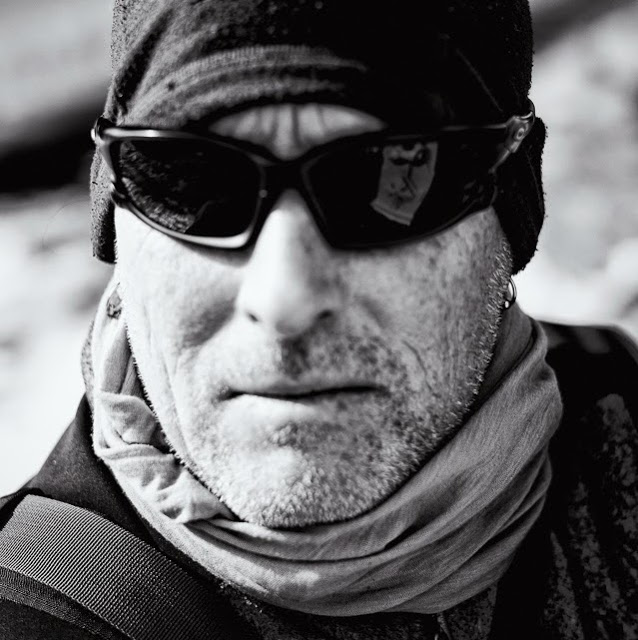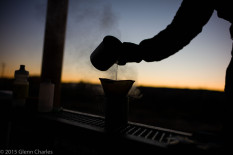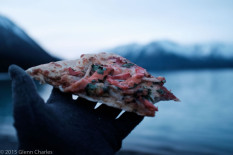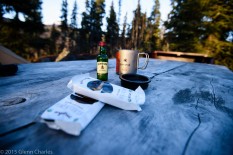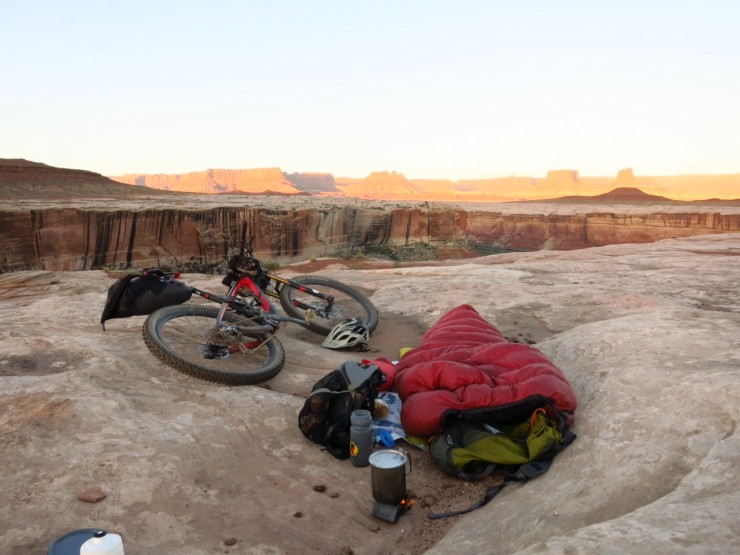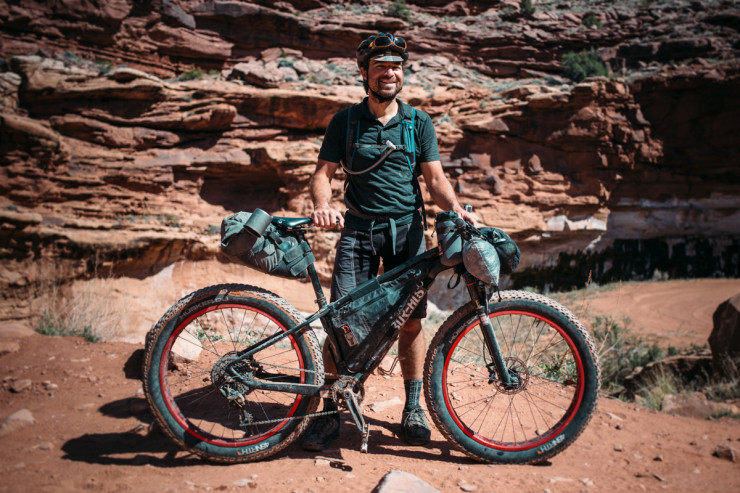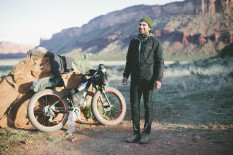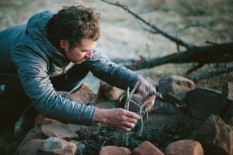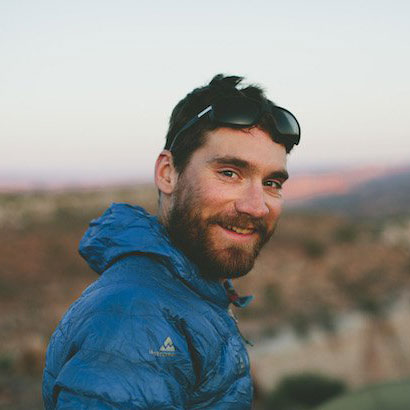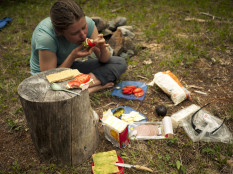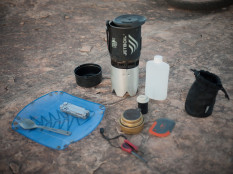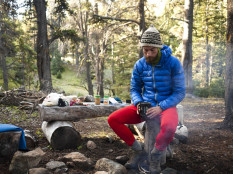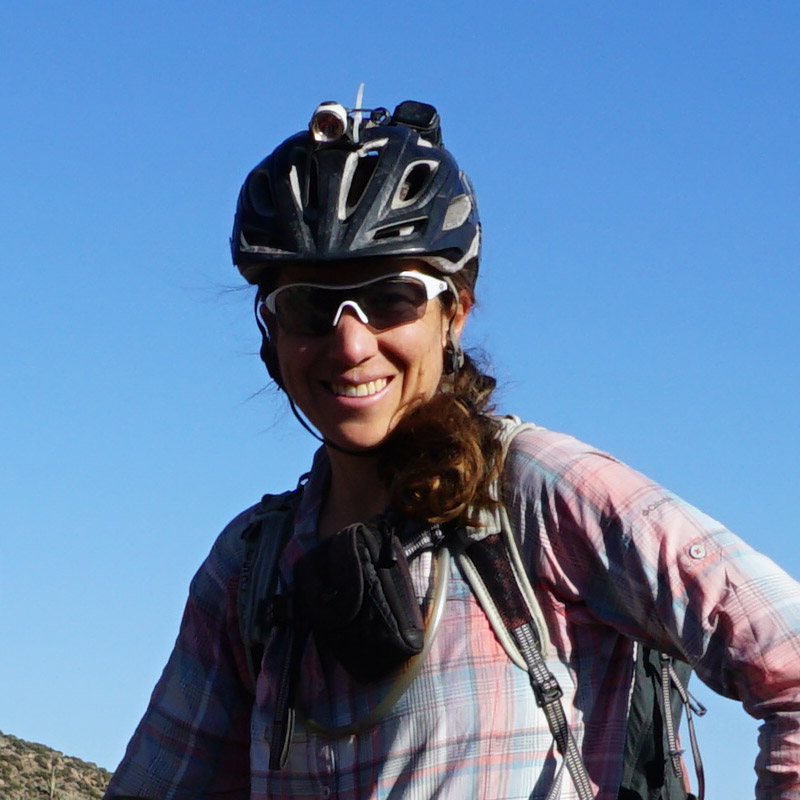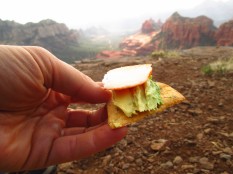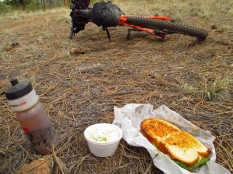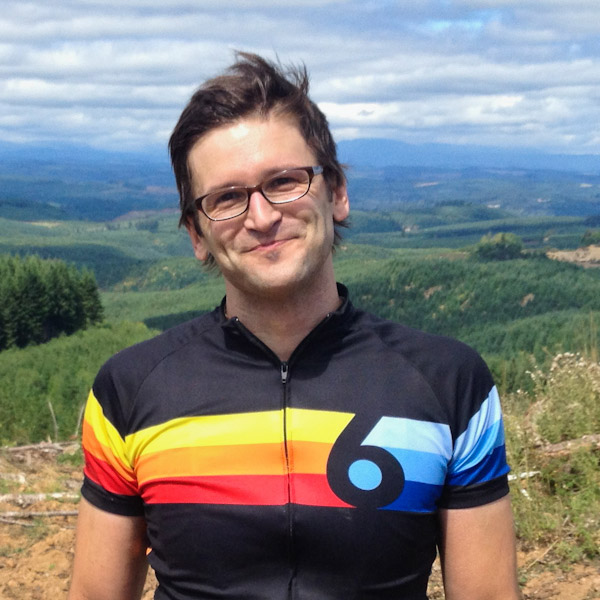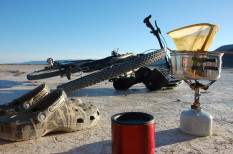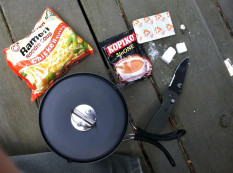Foodpacking: Bikepacking Meal Plans by 6 Riders
Share This
What do folks eat on a backcountry bikepacking trip? How do they plan, pack, and cook? Find out how seasoned riders Glenn Charles, Brendan Collier, Joe Cruz, Skyler Des Roches, Eszter Horyani, and Donnie Kolb plan and prepare food for a 3 day bikepacking trip…
We were interested in hearing how others cook, eat, and drink on bikepacking trips, so we asked. The idea was born from a bikepack with new friends on the Kokopelli Trail and an avid curiosity as to what others use for energy and how they maintain calories while preserving a lightweight setup. This first installment explores how experienced bikepackers eat when they are out on the typical long weekend (three day) bikepacking trip. Here are detailed backlists and information from Glenn Charles, Brendan Collier, Joe Cruz, Skyler Des Roches, Eszter Horyani, and Donnie Kolb. There is some great stuff here and you can see how different minds approach the same subject.
While out on a three to four day bikepacking trip, what do you eat, how do you cook, and where do you pack it all?
Glenn is a traveller, writer, photographer, and Jupiter’s Traveller Recipient. Follow his journey at thetravelingvagabond.com.
“What I eat and how I cook, like all things related to my travel by bike, has evolved over the recent years. If anything, I have made a push towards eating ‘fresher’ ingredients with a focus on dense calories and cooking that minimizes fuel consumption. Because I eat non-stop when traveling, my only big meal is dinner. Everything else is largely based on food consumption every hour of my travel day. Below is my current shopping list for a domestic 3 day, 2-night trip…”
How Do I cook?
This is another evolution in my setup. I have gone from primarily using an alcohol stove to now using a Snow Peak canister stove mated with a Snow Peak pot kit. I have varying sizes of pots that I select from based on the trip and how I am planning on eating. I find that I just want to eat or drink coffee as quickly as possible and am willing to pay the weight penalty on the canister. My Snow Peak Ti stove is lighter than my Trangia, which minimizes the weight penalty. So if I am somewhere that I can get canisters, I go that route and if not, I will go with the Trangia. Since I am only doing one boil at night and one boil in the AM with no real extended cooking, I get extremely good fuel burn rates.
Shopping List
- Coffee beans, locally roasted if possible
- Organic Granola, 2-3 cups worth
- 6-8 packets of Justins Organic Almond butter. A mixture of flavors
- Organic GORP. 20 ounces is generally enough
- 6-8 Lara Bars
- 6 packages of shot blocks
- Small container of hummus
- 1 avocado
- 2 large apples cut up and bagged
- Can of Pringles, crushed up and transferred to a zip lock bag
- Medium block of cheddar cheese
- Some type of hard sausage
- Small vial of olive oil or butter if temps will support
- 2 servings of Organic noodles. I prefer Udon noodles as they are nutritious and cook incredibly quickly. If they are unavailable I turn to Organic Ramen with regular ramen being my last choice.
- 2 servings of Protein. My current preference is the Patagonia Provisions Salmon. A bit expensive but great stuff. I now stock up on it and carry it with me whenever possible.
- One Package of Patagonia Provisions Tsampa soup. This stuff is amazing and a key element for me on longer trips. Highly nutritious and weighs next to nothing. The only downside is it requires a longer cook time than just noodles.
- A mix of chocolate ranging from Dark Chocolate bars to Justins Peanut Butter Cups
- 1 Good To Go rehydrated meal if I still have space. This is an emergency serving of delicious pre-packaged food
Breakfast
Goal is minimal cooking, and around 500 to 800 calories…
- Coffee hand ground and dripped through my Snow Peak pour over
- Organic Granola with a touch of hot water added from ‘coffee water’ mixed with a package of Justins butter.
- Lara bar before leaving camp
Lunch
Eating fresh and simple is important to me with no cooking required. Note: Day 1 lunch is a prime opportunity to eat left over pizza that you and your buddies had the night before rolling out. Whenever possible I try and do this for my first meal of the trip.
- Apples dipped in hummus
- Sliced cheese
- Sliced sausage
- Snack of my choosing
Dinner
Simple, nutritious, close to 1000 calories is the goal…
- Pasta, brought to a boil and then allowed to cook on its own with no flame. A pot cozy comes in handy here and everything cooks up while chores are being performed.
- Sliced cheese, oil and protein added to finished pasta. Soup mix added for extra big days.
- Chocolate and Justins Butter for a snack gets me another 400-500 calories right before bed.
- On longer trips I really like the Good To Go meals as they are made with high quality ingredients and are low in Sodium. For extended trips, I will be going with these as my main dinners, thus eliminating the need to carry my traditional dinner mix. Saves space, and cooks up quick and easy.
Day Snacks
- Gorp, eaten on demand, stored in a large water bottle stashed in a feedbag on the bars
- Lara Bars
- Apple slices
- Shot Blocks
- Chocolate

Where do I carry it?
Snacks are stored all over the bike. Feed bags, Back Pockets, etc. Chocolate bars fit perfectly in the map side of my Frame Bag. Fresh items like apples, hummus, avocado are typically stored in my pocket on my Porcelain Rocket sling if that is my setup. With my new Fat Bike Carradice bag, more things go there which makes carrying bulky food items WAY easier. My frame bag carries the cook kit, fuel, and a small bag with a mixture of snacks and Justins. The bulk of the remaining items are stowed in the seat bag, typically divided up in a bag for Breakfast/Dinner and then one for Lunch.
Hydration
To store water, I use a combination of feedbags, fork mounts, and traditional bottle mounts. I don’t wear a back pack except on the full-suspension bike, so I maximize those water bottle mounts. The fat bike can carry a 64-ounce Klean canteen on the bottom down tube, which is awesome. I typically count on 4 liters a day unless I am in really warm conditions. In regions where water is readily accessible I may opt to carry less knowing that I can resupply strategically during the day.
I have always used two part chemicals or boiling to handle water. However, I am going to be experimenting with some other systems this year in an attempt to drink water that does not have a nasty chemical taste.
Brendan is co-owner and operator of The Hub Cyclery, a bikepacking-focused shop in Idylwild, California. Brendan also founded and started the famed bikepacking route, the Stagecoach 400.
For me, there is no standard food packout, just as there isn’t really a standard gear packout for a bikepacking trip. I have wild variation in my bikepacking menu from one trip to another. The route, the crew I’m headed out with, and even my own fitness level are all factors to consider. On some trips I might be able to carry heavier, more luxurious gear such as a proper camp stove, but on other trips I might need to keep the packing lighter & simpler for less time and effort. And everything in-between.
Touring Pace, Riding With Friends
These are the trips when many of us in the Idyllwild bikepacking crew like to wow one another with delicious treats in camp.
Divy up the (work)load.
Each person in the group can contribute something special for a given meal. Consider sharing gear, too, such as the camp stove and cook wear. Take turns cooking meals so everyone gets more time in camp to relax.
Bring real food
My buddy Dave sometimes brings a home-prepared portion of sushi rice. He makes fresh rolls for us in camp with some pieces of dried seaweed, and a can of eel, seasoned bonito or Spam, and avocado or cucumbers and sometimes a pickled radish. The beauty of Dave’s bikepacking dinners is while they’re delicious, every component also keeps well and packs viable calories for riding. I have come to enjoy our meals in camp as much as the riding to get there.
Marlin packs cold pizza for dinner. Since it’s flat it can fit in just about anywhere, even in frame bag. He’s also carried a block of parmesan, which keeps exceptionally well and can be a tasty mid-day treat on crackers or with slices of apple.
Take advantage of the freezer
Portion out some cheese, toss in the freezer and it will keep very well for up to 3 days on the bike if you bury it somewhere in your gear that’s well insulated, like near your sleeping bag or clothes. (Ditto for frozen butter) Frozen berries are a delightful treat anytime during the day or mixed in with morning oatmeal.
Pack sturdy fruits & vegetables
Broccoli, apples, onions, potatoes. Avocados are a bit less sturdy but well worth the effort! Put the fragile stuff inside hard containers. I have carried fresh eggs, wrapped in a bandana inside my titanium cook mug.
Sturdy staples
Tortillas & Nutella may have been made for bikepacking. Get your beer in cans so you can pack them out. Wine goes in theGSI Wine Flask. (wine, by the way, carries a load of sugars from grapes and can metabolize quite well- plus it might be gentler and less filling on the stomach than beer).
Raid the bulk aisle
Those dried foods pack, portion, and keep very well with great weight-to-calories ratio. Potato flakes are indispensable for a lightweight, viable starch, and they also thicken *anything* you accidentally added too much water to. Where water sources are available I have cooked up chicken alfredo using dry pasta & sauce, some frozen butter & frozen cheese, and a can of chicken and fresh broccoli. Voila! It’s pretty tasty.
Eat the heavy stuff first
Ditto for the stuff that’ll expire sooner. This way you’ll always be eating the best you can and carrying the least weight. win/win. If you’re wearing a backpack, load that heavy/fragile stuff on your initial packout in the backpack. This way you’ll feel your load lighten on the back once it’s gone and feel all the better for the rest of your ride.
Baking
If I’m feeling extravagant and have the room for the load, I’ll carry my Backcountry Oven along. Baking brings a whole new array of menu, such as pizza with premade dough and that frozen cheese, or even brownies. I have premixed brownie batter in a ziplock bag, then simply cut a corner off the bag to squeeze out the yumminess into the baking pan.
Bikepack Racing or Big Personal Efforts
When I’m going light & fast, I might only carry “robot food” and other items we likely won’t find on the route.
Remove wrappers, and pre-portion your robot food
For me that’s generally a few baggies of Skratch Labs powdered drink, which I dose ahead of time with homeopathic Arnica to help manage swelling. I drink these bottles when I need a light pick-me-up, maybe only 2-3 bottles of this over the course of an intense 14-18 hour day.
Mix your pills into water
When I need more electrolytes, I’ll break open a couple Hammer Nutrition Endurolytes capsules and mix them into my water. I have come to believe a “steady drip” of electrolytes is more effective for me over the long haul rather than simply swallowing the capsules, which I feel can spike the electrolyte level too rapidly and gets expelled more quickly via the renal system.
Start your day off with a clear head
I start every day during a big effort with a packet of Emergen-C or a half of a lemon squeezed into a water bottle. Either of these help relieve that bags under the eyes and other swelling that seems to come with big, hard rides. I am a believer in using lemon water to help alkalize the digestive system. I can only report my own anecdotes- it sure makes me feel good first thing in the morning. (don’t double up on these unless you have a potty very close by).
Nuts, I’m going nuts
On the bike, I eat a lot of nuts. Mixed nuts and trail mix with some M&M’s give good long-burn energy and are very satiating for a grumbly belly. More recently I have come to enjoy a product called Trail Butter, which we carry at the shop. (we haven’t put it on the online store yet, otherwise I’d link to it here) Made from nuts, dried fruits, and other goodies such as maple syrup or espresso, these squeeze packets carry more than 700 calories in a 4 ounce pouch with a resealable cap. They’re easy to pack in a handlebar bag or pocket and have saved me from many rough afternoons. They cost about 5 bucks and keep very well.
A cheese sandwich (on bread or even a burrito) does me well, packs nicely and keeps for at least a full day. When I pass by a store I might pick up a can of chicken noodle soup and drink it on the spot. Calories, fluids, and much-craved salt all in one easily digested package.
Fritos
Quite possibly the most underrated endurance fuel. Available everywhere, sturdy for packing, and calorie dense. Three ingredients are Corn, Oil, and Salt.
Get robot food on board as soon as you stop
For the evenings, I’ll pack a few baggies of a powdered recovery drink such as Muscle Milk. I keep them pre-portioned in ziplocks, one for each night out, and packed in with my sleep gear. If I’m going to stop long enough to use my sleep gear, I can also use that time for recovery nutrition. Two scoops of Muscle Milk in a ziplock bag packs more than 300 calories and weighs only 70 grams. I have made a habit of consuming a the recovery powder the moment I arrive in camp. Once that’s on board I can unpack my sleep gear, kick up my feet and enjoy some real food and a beer. My choice for dinner is often a pollo asado burrito or something else similarly “heavy” that I couldn’t otherwise digest during the day.
Emergency food
What can I say, I like canned sardines! Even better are the smoked trout fillets from Trader Joes. This stuff keeps forever and is oh so very satisfying.
Joe Cruz is an intrepid adventurer whose off road tours have taken him throughout the US, Asia, Europe, the Middle East and the length of South America. His writing and photography can be found at Pedaling In Place.
“I’m fussy and a nerd about a thousand things. I try not to let camp cooking be yet another one. Instead, I’m looking for compactness, ease of one-pot preparation, decent calorie density, and invitingness of the tastes.”
Breakfast
For breakfast, I expect to fire the stove for a hot drink and oatmeal, but if fuel is an issue I might change things up with a cold breakfast drawing from the lunch/snack palette. My typical list includes quick oatmeal, raisins, hibiscus Tea bags or Starbucks Via packets.
Lunch/Snacks
My habit for the middle of the day is probably familiar to cyclists: I’ll take small breaks for nuts and an apple or dried fruit, and a longer lunch of the tortillas with avocado, tomato, cheese, and salt. An afternoon snack might be a tortilla with peanut butter.
- Peanut butter
- Pack of tortillas
- 2 Avocados
- 2 Apples
- Dried mangoes
- 2 tomatoes
- Canister of fancy salt
- Block of cheese
- Pack of crackers
- Nuts
- Hard candies, e.g., Jolly Ranchers
Dinner
For dinner, the first thing—especially if it’s chilly—will be a couple of packets of instant soup to sip while I’m setting up camp. Then the couscous with dry bean mix or couscous with the (heavier but delicious) indian dinner. The latter gets heated up in the water that I’ll eventually prepare the couscous with. Cheese often makes a cameo at dinner, too.
- Soup packets
- Couscous or quinoa
- Dehydrated spicy black beans
- Indian dinner in foil packet, dhal or chana
- And, finally, dessert is chocolate and maybe some sporkfulls of PB as well as a sip of whiskey.
How I Pack
With regard to packing, snacks get distributed across the Revelate gas tank, the shell mittens that are clipped to the bars, and the two side pouches on the front pocket, which are perfect for the avocados. Lunch options should be easily accessible, and that usually means they are behind the main zipper of the frame bag. Dinner can be packed deep into bags, and is usually distributed lower in the frame bag and close to the seatpost in the saddle bag, behind the light soft stuff like a sleeping bag and puff jacket. This is to minimize saddlebag swaying or sagging. Enough whiskey—Laphroaig if I’m on the ball—for sharing goes in a small kleen kanteen bottle.
Skyler Vancouver based climber, bikepacker and ski mountaineer. Follow Skyler’s travels at OffRoute.ca. And find his full 3-day desert pack list here.
“My general objective while packing food is to assemble some collection of foods that weight about 1kg per day, and have an average calorie density of at least 4Cal/g. Pure carbohydrate and pure protein are about 4Cal/g, fats and oils are 8-9Cal/g. (Pure alcohol is 7Cal/g) But that’s about as scientific as I get. Few items in the grocery store are pure anything, so I shop for a combination of the important athletic fuel nutrient sources – carbs, fat, and salt – and try avoid buying too many items with a low energy density.”
On particularly strenuous trips, which usually means skiing or climbing trips where the weight is on my back, I might aim to increase that average calorie density with fattier foods, and/or to bring less than 1kg per day. On easier, more social, or very short trips I will include low energy ‘luxury’ foods like fresh fruits. Fresh fruits and vegetables are made almost entirely of water, so they can also count toward my water weight on Day 1 of any trip.
Other requirements are that the food is relatively cheap – I have never purchased a prepared dehydrated camping meal – and, depending on what stove and pot I have with me, that it can be cooked by just boiling water.
Cooking
These days I usually carry a Jetboil Zip (0.8L) stove for myself. Occasionally, when I worry about finding fuel mid-trip, I use a Trangia alcohol burner and a home-made pot stand with my Jetboil pot. With either burner, it’s simmering is a challenge, and so I plan meal that just need boiling water like couscous, instant mashed potatoes, or instant dehydrated refried beans. I eat from the pot, and clean it by scraping every last scrap into my mouth with a GSI scraper – I can live with the oil slick on my coffee in the morning.
Packing
I usually carry the majority of my food in my frame bag. Beside my tool kit, food is usually the densest thing I’m carrying, and I like to keep weight low and central. The day’s snacks can go in my bar pocket, and delicate foods (like avocados) go in my seat pack, padded with clothing, if there is space. I don’t like riding with a pack, and prefer drinking from bottles than from a hose, so I mount bottle cages on each blade of my fork. When I need the capacity, I’ll use 1L Zefal Magnum bottles, and add a 1.5-2L bottle below my down tube. Otherwise, I just use two 0.8L bottles.
Packlist
As long as it’s delicious, I have no problem eating the same thing every day. Within reason. So, here are some ideas of what I like to eat:
Breakfast
The classic choice, instant oatmeal, is pretty revolting, and low in energy. Plus, sweet breakfast foods won’t keep you going long, fatty food helps level out the blood sugar. With my body outright rejecting that sugary mess, I tried hard to convince myself that I could eat instant noodles (i.e. ramen) for breakfast. Nope. Instant noodles, instant pooping.
So, now I just eat crackers and peanut butter for breakfast. That’s my only suggestion. I like big, sturdy crackers, like Wasa or Ryvita, or flattened croissants as my peanut butter delivery vehicle. And, I like black tea or coffee with powdered milk in the morning. A breakfast should usually weigh around 250g.
Lunch
Lunch is the heavy meal of the day, since it needs to be edible without cooking (unlike dinner). I aim for a total around 500g, including snacks. Some of my favourite lunch items are:
- Tortillas
- Crackers
- Cheese
- Avocados
- Dried fruit
- Dry salami
- More cheese (150g/day!)
- Instant hummus (add cold water)
- Salt
- Fresh apple and/or tomato (optional luxury)
Snacks
- Dried banana, mango, cranberries, etc.
- Clif bars (2/day)
- Potato chips or tortilla chips (still taste good when crushed)
- Chocolate
- Chick Pea puffs/chips (various Indian snacks, my favourite of which is ‘boondi’)
- Nuun elecotrolyte beverage tablets – makes tasty, fizzy water. The caffeinated cola flavour is the best.
I enjoy nuts, but you’ve got to chew them really really well, or they’ll pass straight through the system and be wasted weight. Since I often snack during very short breaks while bikepacking, nuts aren’t my top choice.
Dinner
My favourite easily assembled instant meals, ranging from petit bourgeois to plebian, are:
- Couscous with feta, dried cranberries, chopped parsley, soup mix, olive oil and pine nuts
- Instant refried beans with cheese, dehydrated onion, and fresh peppers in tortillas
- Instant mashed potatoes with cheese, salami, and olive oil
- Couscous with soup mix, cheese, and olive oil
Eszter is an accomplished bikepacker who holds nearly every bikepacking record worth holding including the women’s record for the 493-mile Colorado Trail Race. Follow Eszter’s travels at Zen On Dirt.
“Most of my food and water choices are based on the idea of going light and fast on rocky and technical trails much more so than choosing food that’s good for you, tastes amazing, or is unique or fun to make. I eat simply in real life and that definitely carries over to bikepacking.”
Generally speaking, for a three-day bikepack, I’m not too concerned about nutrition. I’m not going to get scurvy from not getting enough vitamin C for three days. While I’d love to have fresh fruit or veggies, I don’t have the capacity or the desire to carry items with such high water content, at least not past the first hour or two of the ride. Avocados are my exception to the rule.
Food weight really is fairly high on the priority list for me. I’m lucky that I’m the type of girl who’ll happily eat oats for breakfast even at home, and view any excuse to eat mac and cheese as amazing.
After choosing snacks out of gas stations for so long, I’ve become happily accustomed to eating fairly trashy food without worrying about the toxicity of food coloring. For longer tours, I start to worry about yellow Skittles.
Day 1
Eat a big breakfast in town. Big enough that you don’t have to eat again until mid-afternoon and can subsist on snacks until dinner. Bacon, eggs, hashbrowns, and toast generally do the job for me. Dinner: Breakfast burritos bought from town. Dessert is chocolate and/or cookies.
Day 2
Breakfast: Oats with fixings. Fixing can include a packet of Swissmiss hot chocolate, M&M’s, chai tea powder mix from Trader Joes, jam and/or peanut butter packets from a diner, butter from a diner, dried fruit. (I collect single-serving packets of goodies whenever I find them and take them bikepacking). Breakfast dessert: Pastry or roll of mini-donuts. I like the chocolate covered ones. Zingers, Little Annie Apple Pies, and Big Tex cinnamon rolls are also happily eaten and contain more calories per gram than any other “food” out there. Lunch: Small roll of sausage, block of cheese, tortillas (2-3), Ranch dressing or hot sauce packets from a grocery store deli. Dinner: Box of Mac and Cheese. Annie’s is preferred. Kraft is enjoyed. Generic brand is tolerated. This is generally spiced up with an avocado, hot sauce, or mayo packets from a grocery store deli. Dessert is chocolate and cookies.
Day 3
Breakfast: Oats. Lunch: Fish tacos. Tortillas, packet of tuna or salmon, mayo, avocado, and hot sauce. Dinner: You’d better make it to town by this time or you’re going hungry. Snacks (spread out over three days of riding): King sized bags of Skittles, bag of Peachie-O’s or Happy Colas, Snickers Bar, 2-3 granola bars, Larabar or two, Mentos, ziplock baggie of dried fruit, small baggie of almonds or cashews, small bag of Fritos.
Cooking
As far as cooking goes, I’m hesitant to cook much even if I have my own kitchen, so anything on the trail needs to be made with a single pot of water. Freeze dried meals have so much salt and cost a lot, I aim to avoid them, but Rice-a-Roni, flavored pastas, and mashed potatoes are all a go in my book. Plus, there’s not much packaging and can be picked up in grocery stores in the middle of nowhere.
I carry an MSR Pocket Rocket and a small fuel canister. After ten+ years of service, it’s proved to be a reliable companion and, with a little bit of advanced planning, finding fuel in the US hasn’t been an issue.
Packing
Breakfast/Lunch/Dinner food mostly gets packed in a framebag with overflow going into a pack. The sound of mac and cheese noodles rattling around during a fast descent makes me think of dinner, which is always a good thing. Snacks get put in a GasTank and a feedbag or two for easy access.
For the vast majority of bikepacking trips, I’ve found 100oz bladder of water to be plenty. Unless is scorching hot, I can make it last 6-7 hours as long as I drink a lot before and after. I carry all of my water on my back and anything over 100oz cramps my style. For filtration, I’ll attach a Sawyer in-line filter to my bladder. It’s great for the grab-and-go capabilities.
Bikepacking has recently exploded in popularity, especially in Oregon. No other person has helped this movement more than the man behind VeloDirt.com and OregonBikepacking.com, Donnie Kolb.
“Although I have no hard and fast rules, I prioritize space over weight and value simplicity for dinners. I focus on calorie dense foods even though they tend to be heavy – think nuts, cheeses, butters, cured sausage, etc. And because I don’t want to have to think hard about meal planning or cooking at the end of a long day, I prefer easy meals that taste reasonably good under all circumstances. Compared to folks I usually ride with, my dinners are boring. But I’ve never rolled into camp from a hard day and been too tired to boil water and eat a batch of salty ramen.”
I hate oatmeal. No matter what you do to it, instant oatmeal is boring and I’m usually hungry almost immediately afterwards. I prefer something simple and tasty, usually a bar of some sort. And after various iterations, I’ve given up on real coffee. It never tastes good enough to justify all the extra stuff/effort to make. Instant 3-in-1 from the Asian grocery is decent enough for a couple days on the trail.
I’m not a racer and I rarely ride hard for extended periods of the day – I’m a plodder. As such, I find I do better on the slow burn, focusing on fats as my main energy source (nuts, cheese, etc.). If I start feeling my energy levels drop, I add some sugar to mix (candy, candy bars, etc.). Towards the end of long hard days when I’m more likely to feel bonky I add in things like Nature Valley Sweet & Salty bars, which always taste good even when I’m not feeling great, and Cliff Bloks.
Day food gets packed in the frame bag, with food specific to that day right inside the front of the zipper for quick access. The rest, including dinners and breakfast, typically ends up in the seat bag with the stove and pot.
Breakfast
- 3-in-1 Kopiko “coffee”
- Snickers
- Nature Valley Sweet & Salty Almond bars
Dinner
- Night 1: Buitoni Tortellini + Ziploc w/ pesto
- Night 2: ramen or rice noodle dinner + cured sausage
Lunch/Riding Snacks
- Cheese ~4-6 oz./day
- Triscuits
- Nuts – Cashews, Blue Diamond Smokehouse or Wasabi almonds, Peanuts
- Nature Valley Sweet & Salty Almond bars
- Candy bars – faves include Snickers, Almond Joy, Peanut M&Ms
- Candy – Jelly Belly, Sour Patch Kids
- Cliff Bloks
- Alternates: Nutella, Justin’s Chocolate Hazelnut Butter
Please keep the conversation civil, constructive, and inclusive, or your comment will be removed.













